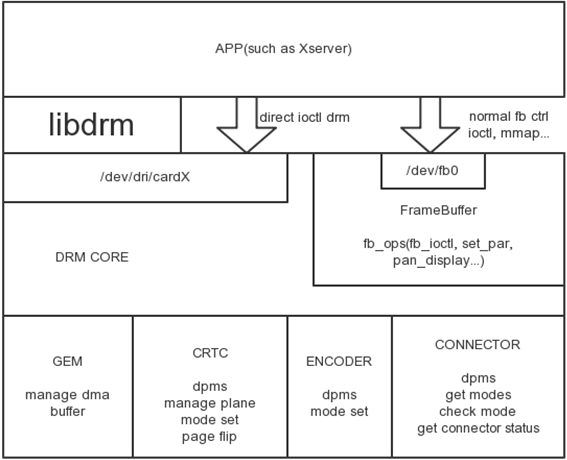Linux Display study
The Direct Rendering Manager (DRM) is a subsystem of the Linux kernel responsible for
interfacing with GPUs of modern video cards. DRM exposes an API that user space programs
can use to send commands and data to the GPU, and perform operations such as configuring
the mode setting of the display. DRM was first developed as the kernel space component of
the X Server's Direct Rendering Infrastructure, but since then it has been used by other
graphic stack alternatives such as Wayland.
Ap -> [DRM API] -> libDrm -> [ioctls ]-> DRM driver
libDrm:
vblank event handling, memory management, output management, framebuffer management, command submission & fencing, suspend/resume support, DMA services.
DRM driver:
drm_driver structure
u32 driver_features; //use AGP,use GEM mem manager, support KMS interfaces, DRM prime buffer sharing, int (*load) (struct drm_device *, unsigned long flags); //driver and device initialization entry point.
Memory management
DRM currently contains two memory managers, the Translation Table Manager (TTM) and the Graphics Execution Manager (GEM).
'GEM'
GEM exposes a set of standard memory-related operations to userspace and a set of helper functions to drivers, and let drivers implement hardware-specific operations with their own private API.
Types of operation:
- Memory allocation and freeing
- Command execution
- Aperture management at command execution time
drm_gem_object_init: will create an shmfs file
drm_gem_private_object_init: create GEM objects with no shmfs backing
drm_gem_object_alloc: to allocate and initialize a struct drm_gem_object instance, if no need to extend with privae info.
drm_gem_object_reference and drm_gem_object_unreference: reference count
communication GEM object between user/kernel space: local handles, global names or,file descriptors.
drm_gem_handle_create: create handle from DRM file and GEM object.
drm_gem_handle_delete:
cross process communication use Name.
DRM_IOCTL_GEM_FLINK : handle to name called in user space
DRM_IOCTL_GEM_OPEN: name to handle
https://blog.csdn.net/yangkuanqaz85988/article/details/48689521
DRM
